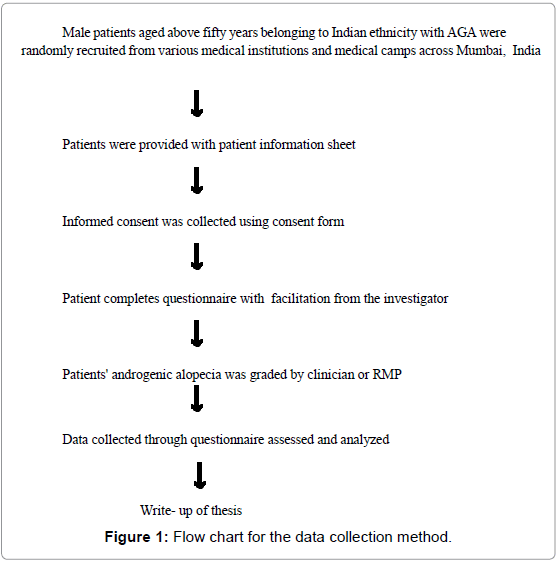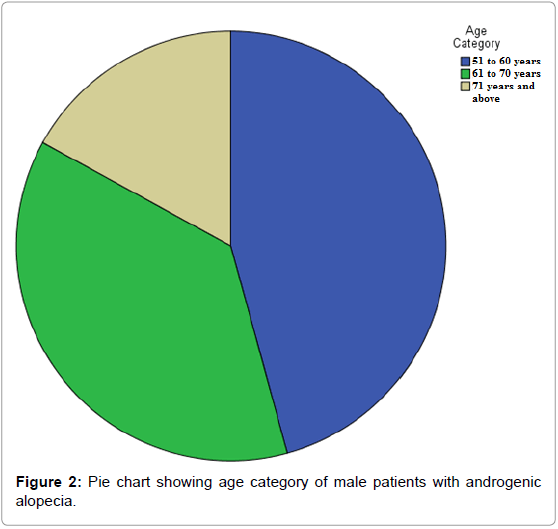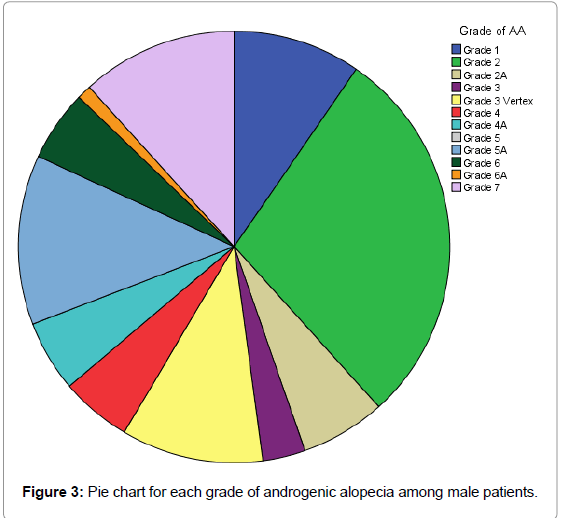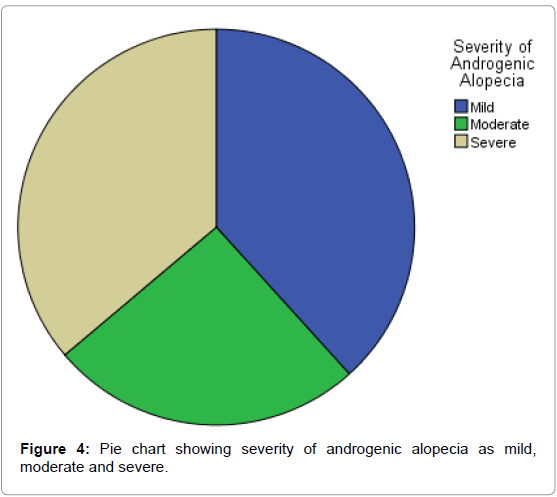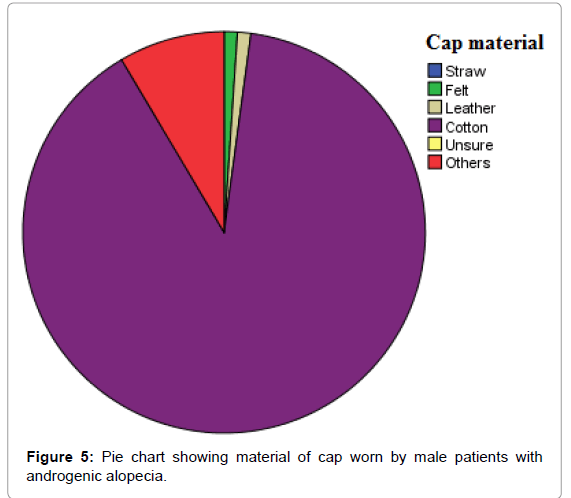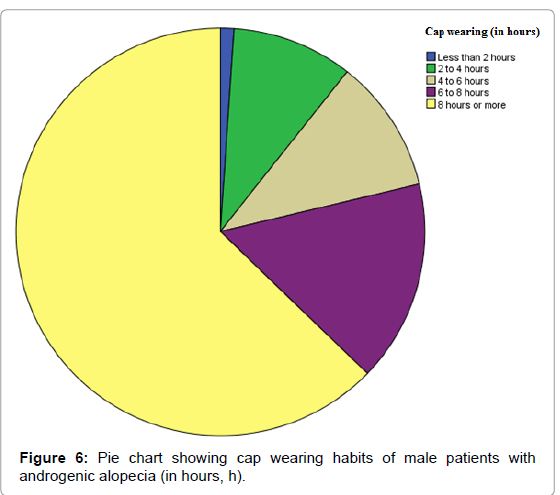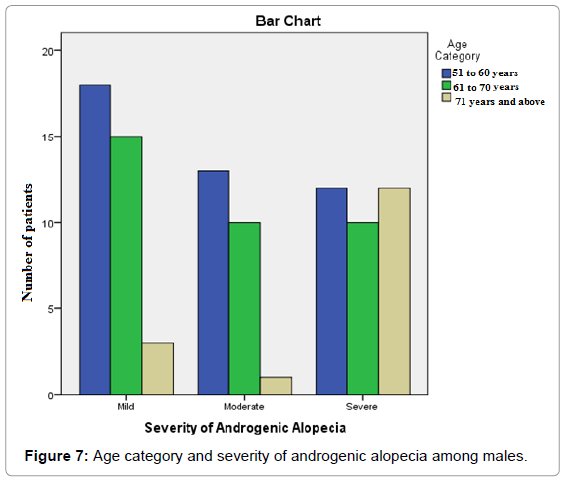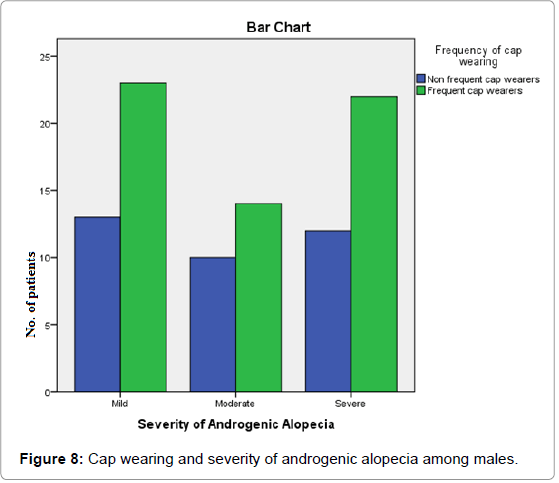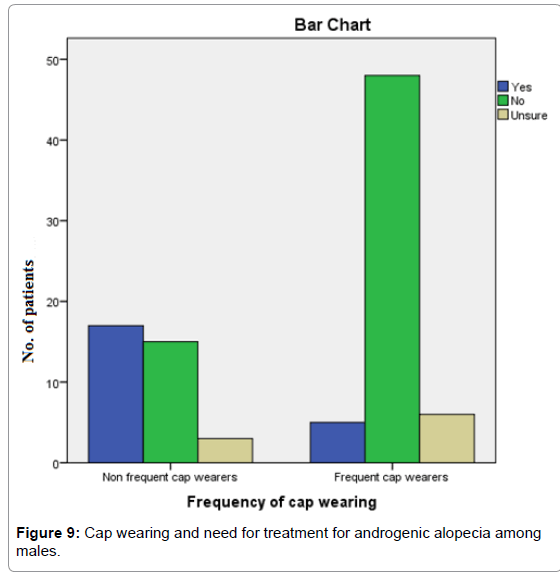Research Article Open Access
Cap Wearing and Quality of Life in Patients with Androgenic Alopecia amongst Indian Population
Juzer Abbasi*, Mustansir Abbasi, Chew Kek Lee, Chung Keat Tan, Eugenie Sin Sing Tan and Navedur RehmanDepartment of Medicine and Health Science, School of Healthy Aging, Regenerative Medicine and Medical Aesthetics, UCSI University, Kuala Lumpur, Malaysia
- *Corresponding Author:
- Juzer Abbasi, M.B.B.S., M.Sc.
Faculty of Medicine and Health Science
School of Healthy Aging, Regenerative Medicine and Medical Aesthetics
UCSI University, Kuala Lumpur, Malaysia
Tel: +919821299952
E-mail: jzrabbasi@yahoo.co.in
Received date: April 11, 2017; Accepted date: April 22, 2017; Published date: April 29, 2017
Citation: Abbasi J, Abbasi M, Lee CK, Tan CK, Tan ESS, et al. (2017) Cap Wearing and Quality of Life in Patients with Androgenic Alopecia amongst Indian Population. J Comm Pub Health Nursing 3:169. doi:10.4172/2471-9846.1000169
Copyright: © 2017 Abbasi J, et al. This is an open-access article distributed under the terms of the Creative Commons Attribution License, which permits unrestricted use, distribution, and reproduction in any medium, provided the original author and source are credited.
Visit for more related articles at Journal of Community & Public Health Nursing
Abstract
Androgenic or androgenetic alopecia is a very frequent cause of hair loss affecting males over 50 years of age. For ages, wearing a cap which covers the frontal, parietal and upper parts of temporal and occipital areas of the scalp is commonly employed as a tradition in males. These areas coincide with the affected area in androgenic alopecia. Hence, a cross-sectional questionnaire study was conducted to analyze the association between cap wearing habits and quality of life with androgenic alopecia among Indian male patients aged above 50 years. Skindex-29 was used as a tool to assess quality of life in these patients. Based on the results, we found no significant association between cap wearing habits and quality of life in Indian males with androgenic alopecia (p=0.348). But, quality of life was highly associated with the severity of androgenic alopecia among Indian male patients (p=0.003) indicating that the more severe the androgenic alopecia, the poorer is the patient’s quality of life. We also find that as the patient’s age increases, the more severe is the androgenic alopecia among Indian males (p=0.012). Also as their hours of cap wearing increases, their desire to undergo treatment for their androgenic alopecia also decreases substantially (p=0.001). Thus cap wearing frequency has no effect on quality of life in Indian males with androgenic alopecia. Severity of androgenic alopecia has a profound effect on quality of life among Indian male patients. With increasing age, the severity of androgenic alopecia also increases. Frequency of cap wearing has no effect on severity of androgenic alopecia. Increasing hours of cap wearing showed decrease in interest to seek medical treatment.
Keywords
Patients; Androgenic alopecia; Quality of life; Population
Introduction
Androgenic alopecia or androgenetic alopecia is a very common cause of loss of hair (baldness) affecting both sexes men and women. In men, there is loss of hair in a pattern beginning above both temples and then later the hairline will recede forming a characteristic “M” shape. Hair then later will thin at the crown (which is near top of head), and then later on will progress to partial or to complete baldness [1].
Androgenic alopecia is more commonly seen in men and starts very early as in teenage and increasing with age. It is estimated that more than fifty percent of men aged fifty years and above have some hair loss due to androgenic alopecia [1]. Thus it is a very commonly encountered problem with aging especially in elderly men. [2].
Today many environmental and genetic factors are thought to be the cause of androgenic alopecia. However, most of them are unproven. Having a first degree or a close relative with androgenic alopecia is a risk factor for its development [1].
As balding is commonly associated with aging, balding makes people feel old and aged leading to feeling of distress and weary. Thus it has an impact on their way of life and may even depress them to a great extent [3]. These patients are also known for rating their loss of hair as more severe than what is actually visible by others [4].
Personal attractiveness and social life is affected to a greater extent in male patients with androgenic alopecia [5]. Low confidence and low self- esteem in also seen in majority of patients with androgenic alopecia [6]. Hence, importance needs to be given on how help can be given to these patients in the most reasonable, easily affordable and with better compliance [2].
More recently, hair transplant has become available as a treatment option for these patients. However, due to the high cost of this treatment modality, many patients do not seek this option. Other treatment option such as minoxidil topical solution or finasteride is not considered feasible by many due to less availability and non-compliance. Thus more research in this field is required to help these patients [7].
For ages, it has been seen that in various communities, across the world, wearing a cap is very commonly seen. For example, in Muslim community, in Jewish community and in Zoroastrian community wearing a cap which covers the frontal, parietal, temporal and upper parts of occipital areas of the scalp is commonly employed as a tradition in males. Some men wear it throughout the day, some men wear it only when they are outdoors and some men wear it only during their religious prayers and practices [8-10].
Men who suffer from androgenic alopecia always feel that it is a very severe condition with lot of distress on life and many people do not see and consider them well in society [3]. Balding is therefore always associated with ageing and this desire to look young is always present in them [11]. Thus in our opinion wearing such a cap can help alleviate such distress and make them feel younger and more socially acceptable.
Materials and Methods
PICO framework
• Population: Male androgenic alopecia patients aged above fifty years (Ninety Seven patients).
• Intervention: Nil.
• Comparator: Male with androgenic alopecia who wears cap regularly (8 h or more) compared to male with androgenic alopecia who doesn’t wear cap regularly (less than 8 h).
• Outcome: 1. Quality of life as assessed by Skindex-29.
2. Severity of androgenic alopecia.
• Study Design: Cross sectional study.
Study design
This is a pilot study involving Ninety seven male participants belonging to Indian ethnicity over the age of fifty years with androgenic alopecia. A questionnaire based survey was conducted in them. Written informed consent was obtained from the patients prior to their participation in the study. The study was conducted in agreement with guidelines of the Declaration of Helsinki.
This study has been approved by Intersystem Biomedical Ethics Committee in Mumbai, India and the UCSI ethics committee were notified on the approval.
Sampling design
Ninety Seven male patients belonging to Indian ethnicity aged above fifty years with androgenic alopecia was conveniently sampled among patients and volunteers visiting various hospitals and institutes.
Venue of sampling: Hospital and medical camps in Mumbai, Maharashtra, India.
Duration of sampling: December 2014 to March 2015 (4 months).
Inclusion criteria
The inclusion criteria were as follows:
Male patients belonging to Indian ethnicity aged above fifty years diagnosed as having androgenic alopecia [12] by a registered medical practitioner (R.M.P.) or clinician were recruited in this study.
Exclusion criteria
The exclusion criteria were as follows:
• Patients with any scalp medical condition.
• Patients with any existing medical condition.
Data Collection Methods
Male patients aged above fifty years belonging to Indian ethnicity who fulfilled the above criteria were conveniently recruited from various medical camps and institutions across Mumbai, India. They were given full information about the study and proper informed consent will be taken. Then a questionnaire was provided to them and they were instructed to answer them with facilitation from the investigator. Then the patient’s AGA was graded as per Norwood-Hamilton scale of malepattern baldness by a registered medical practitioner (R.M.P.) or a clinician [13].
Then the data collected was analyzed. The scores for all 28 questions of Skindex-29 will be given a number which ranges from 1 (never) to 5 (always) depending on the information given by the patient (as one question was removed as ‘my scalp burns or stings’ not relevant to the study). Then the total scores for each patient was calculated and comparison between frequent cap wearing group and non-frequent cap wearers (control) was done as well as for each scale (emotion, function and symptom scale for Skindex. They were also enquired whether they would be interested to undergo medical treatment for their AGA. Comparison between grades of AGA and the total scores for the patients also took place. Results were then drawn accordingly (Figure 1).
Data or Statistical Analysis
SPSS, version 20 was used for statistical analysis.
Values were expressed as a mean ± SD.
The association between categorical variables such as age category, severity of androgenic alopecia, cap wearing habits (in hours, h) and quality of life (QoL) analyzed by means of ANOVA test and Chi-square analysis where applicable.
Only probability (p) values which was lesser than 0.05 were considered as statistically significant.
Results and Discussion
Generalized results of study
Characteristics of the patients: As a pilot test, a total of Ninety seven male patients were included in this study. Every questionnaire was filled out and returned with a response rate of 100%. Three patients were excluded later as they failed to meet the criteria as mentioned above. Thus a total of ninety four male patients with androgenic alopecia with minimum age 51 and maximum age 84 participated in this study. All patients belonged to the Indian ethnicity from Mumbai, Maharashtra, India (Table 1).
The patients were categorized into three groups based on their age:
| Number (n) | Minimum age (years) | Maximum age (years) | Mean (years) | Standard Deviation |
|---|---|---|---|---|
| 94 | 51 | 84 | 62.57 | 7.701 |
Table 1: Descriptive statistics of age of patients.
• Group 1 (51 to 60 years)
• Group 2 (61 to 70 years)
• Group 3 (71 and above) (Figure 2)
Among them, 45.1% of patients aged 51 to 60 years, 37.2% of patients aged 61 to 70 years and 17% of patients aged above 70 years.
Quality of life assessment of male patients with androgenic alopecia: There are three kinds of scales in this questionnaire: symptom scale (6 items), function scale (12 items) and emotion scale (10 items). The total scores and the individual score assessment for each scale of Skindex-29 was calculated accordingly. The total minimum score will be 28 and the total maximum score will be 140 for each patient (Tables 2 and 3).
Number (n) |
Minimum | Maximum | Mean | Standard Deviation |
|---|---|---|---|---|
| 94 | 28 | 68 | 46.0638 | 10.33296 |
Table 2: Descriptive statistics for total scores as assessed by Skindex-29.
Scale |
Number (n) | Minimum | Maximum | Mean | Standard Deviation |
|---|---|---|---|---|---|
| Symptom | 94 | 6 | 14 | 9.32 | 1.730 |
| Function | 94 | 12 | 31 | 17.24 | 4.990 |
| Emotion | 94 | 10 | 28 | 19.50 | 4.975 |
Table 3: Descriptive statistics for each individual scale (symptom, function and emotion) for Skindex-29.
Grading of androgenic alopecia: There are seven grades of androgenic alopecia which are further classified as: mild (Grade I and II), moderate (Grade II A, III, III A and IV) and severe (Grade IV A, V, V A, VI and VII) [14] (Figure 3).
This grading is further classified as: mild (Grade I and II), moderate (Grade II A, III, III A and IV) and severe (Grade IV A, V, V A, VI and VII) [14] (Figure 4).
Thus there were 36 male patients with mild androgenic alopecia, 24 male patients with moderate androgenic alopecia and 34 male patients with severe androgenic alopecia who participated in the study.
Cap wearing in male patients with androgenic alopecia: 89.4 percent of the 94 male patients who participated in the study wore cap made of cotton, while others wore caps made of leather, felt or other material (Figure 5).
Among the male patients who participated in the study, 62.8 percent wore caps for more than 8 hours, whereas only 15 percent wore cap for 6 to 8 h, 10.6 percent wore caps for 4 to 6 h, 9.6 percent wore cap for 2 to 4 h and 1.1 percent wore cap for less than 2 h (Figure 6).
Those wearing cap for eight hours or more were considered as frequent cap wearers and those who wore cap for less than 8 h were considered as non-frequent cap wearers.
Cap wearing and quality of life assessment in male patients with AGA
Association between total Skindex-29 scores and cap wearing in males with androgenic alopecia: Total Skindex-29 scores and cap wearing frequency as frequent (8 h or more) and non-frequent (less than 8 h) (Table 4):
This association was analysed using ANOVA test and student t test for equality of means as follows (Table 5):
| Number (n) | Mean | Standard Deviation | Standard Error | 95% Confidence Interval for Mean | Minimum | Maximum | |
|---|---|---|---|---|---|---|---|
| Lower Bound | Upper Bound | ||||||
| Non frequent cap wearers | 35 | 46.2286 | 10.72404 | 1.81269 | 42.5447 | 30 | 68 |
| Frequent cap wearers | 59 | 45.9661 | 10.18614 | 1.32612 | 43.3116 | 28 | 67 |
| Total | 94 | 46.0638 | 10.33296 | 1.06576 | 43.9474 | 28 | 68 |
Table 4: Descriptive statistics showing skindex-29 scores and cap wearing frequency.
Significant level is greater than 0.05, therefore normality is assumed. Hence ANOVA test can be applied (Table 6).
| Levene’s Statistic | difference 1 | difference 2 | Significant level |
|---|---|---|---|
| 0.818 | 3 | 89 | 0.487 |
Table 5: Levene’s test for homogeneity of variances for total skindex-29 scores and cap wearing (in hours, h).
| Sum of Squares | Difference | Mean Square | Frequency | Significance | |
|---|---|---|---|---|---|
| Between Groups | 479.629 | 4 | 119.907 | 1.129 | 0.348 |
| Within Groups | 9449.988 | 89 | 106.18 | ||
| Total | 9929.617 | 93 |
Table 6: Anova test analysis for association between total skindex-29 scores and cap wearing among males with androgenic alopecia.
Thus p=0.348 which means that p>0.05, thus not significant. Therefore there is no significance between Quality of life and cap wearing habits in males with androgenic alopecia.
Now using student t-test to test the difference in Skindex-29 scores between frequent cap wearers (>8 h) and non-frequent cap wearers (<8 h) (Table 7):
| Frequency of cap wearing | N | Mean | Std. Deviation | Std. Error Mean | |
|---|---|---|---|---|---|
| Total Skindex | Non frequency cap wearers | 35 | 46.2286 | 10.72404 | 1.81269 |
| Frequent cap wearers | 59 | 45.9661 | 10.18614 | 1.32612 |
Table 7: Statistics for total Skindex-29 scores and frequency of cap wearing.
Here we see that the mean of scores for non-frequent cap wearers is 46.2286 with standard deviation of 10.72 and the mean of scores for frequent cap wearers is 45.97 with standard deviation of 10.19 (Table 8).
| Levene's Test for Equality of Variances | |
|---|---|
| Frequency | Significance |
| 0.001 | 0.97 |
Table 8: Levene's test for equality of variances.
Here, significant level is greater than 0.05, therefore normality is assumed. The t-test is applied as follows (Table 9):
| T | Difference | Significance (2-tailed) | Mean Difference | Std. Error Difference | 95% Confidence Interval of the Difference Lower | 95% Confidence Interval of the Difference Upper | |
|---|---|---|---|---|---|---|---|
| Equal variances assumed | 0.118 | 92 | 0.906 | 0.26247 | 2.21637 | -4.13944 | 4.66438 |
| Equal variances not assumed | 0.117 | 68.612 | 0.907 | 0.26247 | 2.24599 | -4.2186 | 4.74354 |
Table 9: Student t-test for equality of means for total Skindex-29 and frequency of cap wearing.
Here, as equal variances is assumed, p=0.907 (which means p>0.05) which shows that there is no significant association between total Skindex-29 scores and frequency of cap wearing among male patients with androgenic alopecia.
Association between each scale (symptom, function and emotion) of skindex-29 and cap wearing in males with androgenic alopecia (Table 10): The association between each scale and cap wearing in males with androgenic alopecia is analysed as follows (Table 11):
| Number (n) | Mean | Std. Deviation | Std. Error | 95% Confidence Interval for Mean | Minimum | Maximum | |||
|---|---|---|---|---|---|---|---|---|---|
| Lower Bound | Upper Bound | ||||||||
| Symptom Scale | Non frequent cap wearers | 35 | 9.8 | 1.812 | 0.306 | 9.18 | 10.42 | 7 | 14 |
| Frequent cap wearers | 59 | 9.03 | 1.629 | 0.212 | 8.61 | 9.46 | 6 | 13 | |
| Total | 94 | 9.32 | 1.73 | 0.178 | 8.96 | 9.67 | 6 | 14 | |
| Function Scale | Non frequent cap wearers | 35 | 17.11 | 4.969 | 0.84 | 15.41 | 18.82 | 12 | 31 |
| Frequent cap wearers | Â 59 | 17.32 | 5.043 | 0.657 | 16.01 | 18.64 | 12 | 29 | |
| Total | 94 | 17.24 | 4.99 | 0.515 | 16.22 | 18.27 | 12 | 31 | |
| Emotion Scale | Non frequent cap wearers | 35 | 19.31 | 5.103 | 0.863 | 17.56 | 21.07 | 10 | 28 |
| Frequent cap wearers | 59 | 19.61 | 4.938 | 0.643 | 18.32 | 20.9 | 10 | 28 | |
| Total | 94 | 19.5 | 4.975 | 0.513 | 18.48 | 20.52 | 10 | 28 |
Table 10: Descriptive statistics showing each scale of skindex-29 scores and cap wearing frequency.
Scale |
Levene’s Statistic | Difference 1 | Difference 2 | Significant level |
|---|---|---|---|---|
| Symptom | 1.651 | 3 | 89 | 0.183 |
| Functions | 2.307 | 3 | 89 | 0.082 |
| Emotion | 0.013 | 3 | 89 | 0.998 |
Table 11: Levene’s test for homogeneity of variances for each scale of skindex-29 and cap wearing among males with androgenic alopecia.
Significant level greater than 0.05 for each scale, therefore normality is assumed. Hence ANOVA test can be applied for each scale (Table 12).
| Sum of Squares | Difference | Mean Square | Frequency | Significance | ||
|---|---|---|---|---|---|---|
| Symptom | Between Groups | 27.738 | 4 | 6.934 | 2.462 | 0.051 |
| Within Groups | 250.688 | 89 | 2.817 | |||
| Total | 278.426 | 93 | ||||
| Function | Between Groups | 109.235 | 27.309 | 1.102 | 0.361 | |
| Within Groups | 2206.14 | 4 | 24.788 | |||
| Total | 2315.37 | 89 | ||||
| Emotion | Between Groups | 63.777 | 93 | 15.944 | 0.634 | 0.639 |
| Within Groups | 2237.72 | 89 | 25.143 | |||
| Total | 2301.5 | 93 |
Table 12: ANOVA test analysis for association between each scale of skindex-29 and cap wearing among males with androgenic alopecia.
Thus p>0.05 for each symptom, emotion and function scale (p=0.51 for symptom scale, p=0.361 for function scale and p=0.639 for emotion scale respectively) which shows no significant association. Thus there is no significant association between quality of life as assessed by
| Number (n) | Mean | Std. Deviation | Std. Error | 95% Confidence Interval for Mean | Minimum | Maximum | ||
|---|---|---|---|---|---|---|---|---|
| Lower Bound | Upper Bound | |||||||
| Mild | 36 | 41.3889 | 7.35344 | 1.22557 | 38.9008 | 43.8769 | 28 | 59 |
| Moderate | 24 | 47.4583 | 11.61326 | 2.37055 | 42.5545 | 52.3622 | 29 | 68 |
| Severe | 34 | 50.0294 | 10.39663 | 1.78301 | 46.4019 | 53.657 | 34 | 67 |
| Total | 94 | 46.0638 | 10.33296 | 1.06576 | 43.9474 | 48.182 | 28 | 68 |
Table 13: Descriptive statistics showing total skindex-29 scores and severity of androgenic alopecia.
skindex-29 and cap wearing among males with androgenic alopecia.
Severity and quality of life assessment by SKINDEX-29 among males with AGA
Association between total Skindex-29 scores severity among males with androgenic alopecia (Table 13): The association was analysed as follows (Table 14):
| Levene’s statistic | difference 1 | difference 2 | Significant level |
|---|---|---|---|
| 4.072 | 2 | 91 | 0.020 |
Table 14: 2 Levene’s test for homogeneity of variances for total skindex-29 scores and severity of androgenic alopecia.
Significant level is less than 0.05 which indicates that scores are significantly different from a normal distribution (not normal). Hence ANOVA test cannot be applied here. Therefore, Kruskal Wallis Test is applied to assess the significance of association (Table 15).
| Kruskal Wallis test: Ranks | |||
|---|---|---|---|
| Severity of Androgenic Alopecia | Number (n) | Mean Rank | |
| Total Skindex-29 scores | Mild | 36 | 26.85 |
| Moderate | 24 | 35.98 | |
| Total | 60 | ||
| Kruskal Wallis test: Test Statistics | |||
| Total Skindex | |||
| Chi-Square | 11.62 | ||
| Difference | 2 | ||
| Â Asymp. Sig. | 0.003 |
Table 15: Kruskal Wallis test to assess association between total Skindex-29 scores and severity of androgenic alopecia.
Thus p=0.003, which means p<0.01, thus highly significant. Thus there is a highly significant association between severity of androgenic alopecia and quality of life as assessed by Skindex-29 among males with androgenic alopecia.
Association between each scale (symptom, function and emotion) of skindex-29 and severity among males with androgenic alopecia (Table 16): The association was analysed as follows (Table 17):
| Number (n) | Mean | Std. Deviation | Std. Error | 95% Confidence Interval for Mean | Minimum | Maximum | |||
|---|---|---|---|---|---|---|---|---|---|
| Lower Bound | Upper Bound | ||||||||
| Symptom scale | Mild | 36 | 8.64 | 1.417 | 0.236 | 8.16 | 9.12 | 6 | 11 |
| Moderate | 24 | 9.83 | 1.81 | 0.369 | 9.07 | 10.6 | 6 | 14 | |
| Severe | 34 | 9.68 | 1.788 | 0.307 | 9.05 | 10.3 | 7 | 14 | |
| Total | 94 | 9.32 | 1.73 | 0.178 | 8.96 | 9.67 | 6 | 14 | |
| Function scale | Mild | 36 | 15.06 | 3.125 | 0.521 | 14 | 16.11 | 12 | 23 |
| Moderate | 24 | 17.38 | 5.174 | 1.056 | 15.19 | 19.56 | 12 | 29 | |
| Severe | 34 | 19.47 | 5.55 | 0.952 | 17.53 | 21.41 | 13 | 31 | |
| Total | 94 | 17.24 | 4.99 | 0.515 | 16.22 | 18.27 | 12 | 31 | |
| Emotion scale | Mild | 36 | 17.69 | 4.235 | 0.706 | 16.26 | 19.13 | 10 | 26 |
| Moderate | 24 | 20.25 | 5.81 | 1.186 | 17.8 | 22.7 | 10 | 28 | |
| Severe | 34 | 20.88 | 4.611 | 791 | 19.27 | 22.49 | 12 | 28 | |
| Total | 94 | 19.5 | 4.975 | 0.513 | 18.48 | 20.52 | 10 | 28 | |
Table 16: Descriptive statistics showing each scale of skindex-29 scores and severity of androgenic alopecia.
| Levene’s statistic | difference 1 | difference 2 | Significant level | |
|---|---|---|---|---|
| Symptoms | .831 | 2 | 91 | 0.439 |
| Functions | 8.674 | 2 | 91 | 0.000 |
| Emotion | 1.524 | 2 | 91 | 0.223 |
Table 17: Levene’s test for homogeneity of variances for each scale of skindex-29 and severity among males with androgenic alopecia.
The significant level for symptom and emotion scale is greater than 0.05. Thus for those two scales, normality is assumed and ANOVA test can be applied to analyze significance. However, for the function scale, significant level is less than 0.05 which indicates that scores are significantly different from a normal distribution (not normal). Hence ANOVA test cannot be applied and so Kruskal Wallis Test is applied to assess the significance of association between function scale and severity of androgenic alopecia (Table 18).
| Sum of Squares | Difference | Mean Square | Frequency | Significance | ||
|---|---|---|---|---|---|---|
| Symptom | Between Groups | 27.345 | 2 | 13.673 | 4.955 | 0.009 |
| Within Groups | 251.08 | 91 | 2.759 | |||
| Total | 278.426 | 93 | ||||
| Emotion | Between Groups | 195.832 | 2 | 97.916 | 4.232 | 0.017 |
| Within Groups | 2105.668 | 91 | 23.139 |
Table 18: Anova test analysis for association between symptom and emotion scale of skindex -29 and severity among males with AGA.
For symptom scale and severity of androgenic alopecia, p=0.009, which implies that p<0.01 which means highly significant association. Also for emotion scale and severity of androgenic alopecia, p=0.017 which implies that p<0.05 which means significant association (Table 19).
| Kruskal Wallis test: Ranks | |||
|---|---|---|---|
| Severity of Androgenic Alopecia | Number (n) | Mean Rank | |
| Function scale of Skindex-29 | Mild | 36 | 35.92 |
| Moderate | 24 | 47.21 | |
| Severe | 34 | 59.97 | |
| Total | 94 | ||
| Kruskal Wallis test: Test Statistics | |||
| Function scale | |||
| Chi-Square | 13.74 | ||
| Difference | 2 | ||
| Â Asymp. Sig. | 0.001 |
Table 19: Kruskal Wallis test to assess association between function scale of Skindex-29 and severity of androgenic alopecia.
Here p=0.001, thus p<0.01 implies highly significant association. Thus there is a significant association for quality of life as assessed by each symptom, function and emotion scale of skindex-29 and severity among males with androgenic alopecia.
Association between age category and severity of androgenic alopecia (Table 20)
| Severity of Androgenic Alopecia | Total | |||||
|---|---|---|---|---|---|---|
| Mild | Moderate | Severe | ||||
| 51 to 60 years | Count | 18 | 13 | 12 | 43 | |
| Expected Count | 16.5 | 11 | 15.6 | 43 | ||
| Count | 15 | 10 | 10 | 35 | ||
| Age Category | 61 to 70 years | Expected Count | 13.4 | 8.9 | 12.7 | 35 |
| Count | 3 | 1 | 12 | 16 | ||
| 71 years and above | Expected Count | 6.1 | 4.1 | 5.8 | 16 | |
| Count | 36 | 24 | 34 | 94 | ||
| Total | Expected Count | 36 | 24 | 34 | 94 | |
| Value | Difference | Asymp. Sig. (2-sided) | ||||
| Pearson Chi-Square | 12.798a | 4 | 0.012 | |||
| Likelihood Ratio | 12.681 | 4 | 0.013 | |||
| Linear-by-Linear Association | 5.398 | 1 | 0.02 | |||
| Number of Valid cases | 94 |
a.1 cells (11.1%) have expected count less than 5. The minimum expected count is 4.09.
Table 20: Age category and severity of androgenic alopecia cross tabulation.
From the above table we see that out of 34 male patients with severe androgenic alopecia, 12 patients (35.29%) belonged to the age group 71 years and above. Also out of 36 male patients with mild androgenic alopecia, 18 male patients (50%) belonged to age group 51 to 60 years. The expected count for Pearson Chi-Square is 5. Only 1 cell has an expected count less than 5 and thus do not meet the criteria. However as the age of patients with androgenic alopecia increases, the severity of androgenic alopecia in them also increases proportionately. Thus androgenic alopecia gets more severe when a person grows older. This can be understood by the following graph (Figure 7).
Association between cap wearing and severity of androgenic alopecia (Table 21)
| Cap wearing habits | ||||
|---|---|---|---|---|
| Non frequent cap wearers (less than eight hours) | Frequent cap wearers (8 hours or more) | Total | ||
| Severity of Androgenic Alopecia | Mild | 13 | 23 | 36 |
| Moderate | 10 | 14 | 24 | |
| Severe | 12 | 22 | 34 | |
| Total | 35 | 59 | 94 | |
| Value | Difference | Asymp. Sig. (2-sided) | ||
| Pearson Chi-Square | 0.276a | 2 | 0.871 | |
| Likelihood Ratio | 0.274 | 2 | 0.872 | |
| Linear-by-Linear Association | 0.004 | 1 | 0.95 | |
| Number of Valid cases | 94 | |||
a. 0 cells (0.0%) have expected count less than 5. The minimum expected count is 8.94.
Table 21: Cap wearing and severity of androgenic alopecia cross tabulation.
From the above table, we see that out of 34 male patients with severe androgenic alopecia, 22 (64.71 %) patients wore cap for 8 h or more. Also 14 (58.33%) out of 24 male patients with moderate grade of androgenic alopecia wore cap for 8 h or more. The expected count for Pearson Chi-Square is 5. No cell has an expected count less than 5 and thus meets the criteria. However, there is no significant association between cap wearing and severity among male patients with androgenic alopecia (p=0.871). This can be further understood with the help of the following graph (Figure 8).
Association between cap wearing and need for medical treatment for AGA (Table 22)
| Need for medical treatment for Androgenic Alopecia | Total | ||||
|---|---|---|---|---|---|
| Yes | No | Unsure | |||
| Cap wearing habits (In hours) | Non frequent cap wearers | 17 | 15 | 3 | 35 |
| Frequent cap wearers | Â 5 | Â 49 | 5 | 59 | |
| Total | 22 | 64 | 8 | 94 | |
| Value a | Difference | Asymp. Sig. (2-sided) | |||
| Pearson Chi-Square | 20.008a | 2 | 0 | ||
| Likelihood Ratio | 19.918 | 2 | 0 | ||
| Linear-by-Linear Association | 12.163 | 1 | 0 | ||
| Number of Valid cases | 94 | ||||
a.1 cell (16.7%) has expected count less than 5. The minimum expected count is 3.35.
Table 22: Cap wearing and need for treatment for alopecia cross tabulation.
From the above table, we observe that 49 (83.05%) out of 59 male patients with androgenic alopecia who wear cap for 8 h or more in a day (frequent cap wearer) do not want to seek medical treatment for their androgenic alopecia. Thus patients who wear cap for 8 h or more do not feel the need to seek medical treatment. The expected count for Pearson Chi-Square is 5. Only 1 cell has an expected count less than 5 and thus do not meet the criteria. However, increasing hours of cap wearing among males with AGA showed decrease in interest to seek medical treatment. This can be better understood with the help of the following graph (Figure 9).
Discussion
From the results of this cross sectional study, there is no significant association between quality of life and cap wearing habits (in hours, h) among male patients with androgenic alopecia as assessed for total skindex-29 scores (p=0.348 by ANOVA test and p=0.907 by Student’s t-test) as well as for each symptom, function and emotion scale of skindex-29 (p=0.51, p=0.361 and p=0.639, respectively). Thus, the first hypotheses are proved false. This may be as men aged above fifty years irrespective of their cap wearing habits are happily married and well settled in their professional life and thus their quality of life is not impaired. However, larger sample studies are warranted to effectively analyze the association between cap wearing habits and quality of life among male patients with androgenic alopecia belonging to different ethnicities. There are no similar studies on cap wearing habits among androgenic alopecia patients.
Also, from the results of the above study, there is a highly significant association between quality of life and severity of androgenic alopecia among Indian males aged above fifty years as assessed for total skindex-29 scores (p=0.003, that is p<0.01). Also, when assessed for individual scale of skindex-29, for symptom scale (p=0.009 that is p<0.01) there is a highly significant association between symptom scale scores and severity of androgenic alopecia, also for emotion scale (p=0.017 that is p<0.05), there is a significant association between emotion scale scores and severity of androgenic alopecia as well as for function scale (p=0.001, that is p<0.01), there is a highly significant association between function scale scores and severity of androgenic alopecia. Thus as the severity of androgenic alopecia increases among Indian males, the quality of life also deteriorates proportionately due to psychological effects of alopecia on them and the social stigma of aging associated with it. This is supported by studies done by Han et al. in South Korea in Asian population and Prinsen et al. in Netherlands in Caucasian population where they found significant association between quality of life as assessed by skindex-29 and severity of androgenic alopecia [2,15]. Thus this study can serve as a guideline for male patients with androgenic alopecia in the Indian population.
From the results of the above study, 35.29% Indian male patients with severe androgenic alopecia belong to the age group 71 years and above and 50 % Indian male patients with mild androgenic alopecia belong to the age group 51 to 60 years of age. Thus as one ages, the severity of androgenic alopecia also increases proportionately among Indian males (p=0.012). This is also supported by studies done by Han et al. in the Asian population, Prinsen et al. and Norwood et al. in the Caucasian population and Krupa Shankar et al. and Kaliyadan et al. in the Indian population respectively [2,13,15-17].
Also, from the results of the above study, 64.71% of Indian male patients with severe androgenic alopecia wore cap for 8 h or more in a day (frequent cap wearers). However, there is no significant association between cap wearing and severity among male patients with androgenic alopecia (p=0.871). Here in this study 84.9 percent on males wore loose woven caps made of cotton thus there was no effect of stress on the hair follicles due to tension as well as the excess sweat got absorbed well due to the material of the cap. Hence, due to the small sample size in this study, a larger scale study regarding the association of cap wearing and severity of androgenic alopecia among all ethnic groups in males with androgenic alopecia with all different types of cap materials needs to be conducted in the future so as to justify this relationship as no study has been conducted in the past.
An important finding from the results of the above study is that 83.05% male patients with androgenic alopecia who wear cap for 8 h or more (frequent cap wearers) in a day do not want to seek medical treatment for their androgenic alopecia (p=0.001). Thus, increasing hours of cap wearing among males with AGA showed decrease in interest to seek medical treatment, as wearing a cap for more hours in a day covers their baldness and thus avoids the social stigma of being bald in public and the psychological effects of alopecia in them [18-25].
Conclusion
Based on the results of this pilot cross sectional study we conclude that cap wearing frequency has no effect on quality of life in Indian males with androgenic alopecia (p=0.348 and p=0.907). However, severity of androgenic alopecia has a profound effect on quality of life among Indian male patients (p=0.003) which indicates that the more severe the androgenic alopecia, the poorer is the patient’s quality of life. With increasing age of patients, the severity of androgenic alopecia increases proportionately among Indian males (p=0.012). Frequency of cap wearing has no effect on severity of androgenic alopecia among Indian male patients (p=0.871). Also increasing hours of cap wearing among males with androgenic alopecia showed decrease in interest to seek medical treatment (p=0.001) which implies that wearing a cap for a longer period of time helps to ward off the social stigma and the psychological effects of alopecia in them. This study serves as a baseline to help physicians understand the effects on quality of life in patients with androgenic alopecia as well as in prescribing cap wearing for them on a long term daily basis [25-34].
Limitation of the Study
Being a pilot study, small sample size and including only male patients with androgenic alopecia, aged above fifty years belonging to Indian ethnicity are the limitations of this study. As the objective assessment of the quality of life is not possible to perform, a large part of the assessment is subjective and patient’s response is the only tool for evaluation.
Suggestions for the Future Studies
As this is a pilot study involving a small sample size of only Indian males, multi-centered studies with larger sample size involving both male and female patients with androgenic alopecia belonging to different ethnicities other than Indian is warranted in the future to confirm the association of cap wearing habits and quality of life in patients with androgenic alopecia.
Competing Interests
The authors declare that there is no conflict of interests regarding the publication of this paper.
References
- Yeo IK, Jang WS, Min PK, Cho HR, Cho SW, et al. (2014) An epidemiological study of androgenic alopecia in 3114 Korean patients. Clin Exp Dermatol 39: 25-29.
- Han SH, Byun JW, Lee WS, Kang H, Kye YC, et al. (2012) Quality of life assessment in male patients with androgenetic alopecia: Result of a prospective, multicenter study. Ann Dermatol 24: 311-318.
- Cartwright T, Endean N, Porter A (2009) Illness perceptions, coping and quality of life in patients with alopecia. Br J Dermatol 160: 1034-1039.
- Reid EE, Haley AC, Borovicka JH, Rademaker A, West DP, et al. (2012) Clinical severity does not reliably predict quality of life in women with alopecia areata, telogen effluvium or androgenic alopecia. J Am Acad Dermatol 66: e97-102.
- Alfonso M, Richter-Appelt H, Tosti A, Viera MS, GarcÃa M (2005) The psychosocial impact of hair loss among men: A multinational European study. Curr Med Res Opin 21: 1829-1836.
- Williamson D, Gonzalez M, Finlay AY (2001) The effect of hair loss on quality of life. J Eur Acad Dermatol Venereol 15: 137-139.
- Blumeyer A, Tosti A, Messenger A, Reygagne P, Del Marmol V, et al. (2011) Evidence-based (S3) guideline for the treatment of androgenetic alopecia in women and in men. J Dtsch Dermatol Ges 9: S1-57.
- Osbourne E (2005) RE-buildings, places and artefacts: Teacher book and student book. Michigan State: Folens Publishers.
- Bhadha EDHJ (2009) Effect of wearing cap on zarathustri urvaan. Chapel Hill, North Carolina: Project Gutenberg Self-Publishing press.
- Mansour RE (2014) Wearing a kippa. Brooklyn New York: Daily Halacha.
- Rushton DH (1999) Androgenetic alopecia in men: The scale of the problem and prospects for treatment. Int J Clin Pract 53: 50-53.
- Blume-Peytavi U, Blumeyer A, Tosti A, Finner A, Marmol V, et al. (2011) S1 guideline for diagnostic evaluation in androgenetic alopecia in men, women and adolescents. Br J Dermatol 164: 5-15.
- Norwood OT (1975) Male pattern baldness: Classification and incidence. South Med J 68: 1359-1365.
- Hamilton JB (1951) Patterned loss of hair in man; types and incidence. Ann N Y Acad Sci 53: 708-728.
- Prinsen CA, Lindeboom R, Sprangers MA, Legierse CM, de Korte J (2010) Health-related quality of life assessment in dermatology: Interpretation of Skindex-29 scores using patient-based anchors. J Invest Dermatol 130: 1318-1322.
- Krupa Shankar D, Chakravarthi M, Shilpakar R (2009) Male androgenetic alopecia: Population-based study in 1,005 subjects. Int J Trichology 1: 131-133.
- Kaliyadan F, Nambiar A, Vijayaraghavan S (2013) Androgenetic alopecia: An update. Indian J Dermatol Venereol Leprol 79: 613-625.
- Cash TF (1992) The psychological effects of androgenetic alopecia in men. J Am Acad Dermatol 26: 926-931.
- Cash TF, Price VH, Savin RC (1993) Psychological effects of androgenetic alopecia on women: Comparisons with balding men and with female control subjects. J Am Acad Dermatol 29: 568-575.
- Chren MM, Lasek RJ, Flocke SA, Zyzanski SJ (1997) Improved discriminative and evaluative capability of a refined version of Skindex, a quality-of-life instrument for patients with skin diseases. Arch Dermatol 133: 1433-1440.
- Drake L, Hordinsky M, Fiedler V, Swinehart J, Unger WP, et al. (1999) The effects of finasteride on scalp skin and serum androgen levels in men with androgenetic alopecia. J Am Acad Dermatol 41: 550-554.
- Freund BJ, Schwartz M (2010) Treatment of male pattern baldness with botulinum toxin: A pilot study. Plast Reconstr Surg 126: 246e-248e.
- Jang WS, Son IP, Yeo IK, Park KY, Li K, et al. (2013) The annual changes of clinical manifestation of androgenetic alopecia clinic in korean males and females: A outpatient-based study. Ann Dermatol 25: 181-188.
- Lubahn DB, Joseph DR, Sullivan PM, Willard HF, French FS, et al. (1988) Cloning of human androgen receptor complementary DNA and localization to the X chromosome. Science 240: 327-330.
- Mounsey AL, Reed SW (2009) Diagnosing and treating hair loss. Am Fam Physician 80: 356-362.
- Norwood OT, Lehr B (2000) Female androgenetic alopecia: A separate entity. Dermatol Surg 26: 679-682
- Orentreich N (1959) Autografts in alopecias and other selected dermatological conditions. Ann N Y Acad Sci 83: 463-479.
- Rangwala S, Rashid RM (2012) Alopecia: A review of laser and light therapies. Dermatol Online J 18: 3.
- Sawant N, Chikhalkar S, Mehta V, Ravi M, Madke B, et al. (2010) Androgenetic alopecia: Quality-of-life and associated lifestyle patterns. Int J Trichology 2: 81-85.
- Severi G, Sinclair R, Hopper JL, English DR, McCredie MR, et al. (2003) Androgenetic alopecia in men aged 40-69 years: Prevalence and risk factors. Br J Dermatol 149: 1207-1213.
- Su LH, Chen TH (2007) Association of androgenetic alopecia with smoking and its prevalence among Asian men: A community-based survey. Arch Dermatol 143: 1401-1406.
- Tang L, Bernardo O, Bolduc C, Lui H, Madani S, et al. (2003) The expression of insulin-like growth factor 1 in follicular dermal papillae correlates with therapeutic efficacy of finasteride in androgenetic alopecia. J Am Acad Dermatol 49: 229-233.
- Tsuboi R, Itami S, Inui S, Ueki R, Katsuoka K, et al. (2012) Guidelines for the management of androgenetic alopecia (2010). J Dermatol 39: 113-120.
- Xu F, Sheng YY, Mu ZL, Lou W, Zhou J, et al. (2009) Prevalence and types of androgenetic alopecia in Shanghai, China: A community-based study. Br J Dermatol 160: 629-632.
Relevant Topics
- Chronic Disease Management
- Community Based Nursing
- Community Health Assessment
- Community Health Nursing Care
- Community Nursing
- Community Nursing Care
- Community Nursing Diagnosis
- Community Nursing Intervention
- Core Functions Of Public Health Nursing
- Epidemiology
- Epidemiology in community nursing
- Health education
- Health Equity
- Health Promotion
- History Of Public Health Nursing
- Nursing Public Health
- Public Health Nursing
- Risk Factors And Burnout And Public Health Nursing
- Risk Factors and Burnout and Public Health Nursing
Recommended Journals
- Epidemiology journal
- Global Journal of Nursing & Forensic Studies
- Global Nursing & Forensic Studies Journal
- global journal of nursing & forensic studies
- journal of community medicine& health education
- journal of community medicine& health education
- Palliative Care & Medicine journal
- journal of pregnancy and child health
Article Tools
Article Usage
- Total views: 4374
- [From(publication date):
May-2017 - Dec 19, 2024] - Breakdown by view type
- HTML page views : 3715
- PDF downloads : 659

